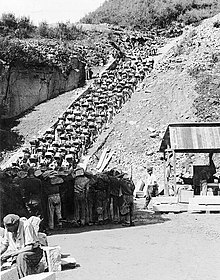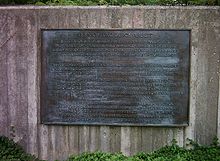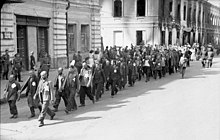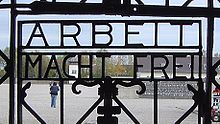Extermination through labour


Extermination through labour (or "extermination through work", German: Vernichtung durch Arbeit) is a term that was adopted to describe forced labor in Nazi concentration camps whose inmates were held in inhumane conditions and suffered a high mortality rate; in some camps most prisoners died within a few months of incarceration.[1] In the 21st century, research has questioned whether there was a general policy of extermination through labor in the Nazi concentration camp system because of widely varying conditions between camps.[2] German historian Jens-Christian Wagner argues that the camp system involved the exploitation of forced labor of some prisoners and the systematic murder of others, especially Jews, with only limited overlap between these two groups.[1]
Some writers, notably Aleksandr Solzhenitsyn, have written that the Soviet Gulag system was also a form of extermination through labour. Similar statements have been made about the Laogai system under Mao Zedong's China.
Terminology
[edit]The term "extermination through labour" (Vernichtung durch Arbeit) was not generally used by the Nazi SS. However, it was specifically employed by Joseph Goebbels and Otto Georg Thierack in late 1942 negotiations involving them, Albert Bormann, and Heinrich Himmler, relating to the transfer of prisoners to concentration camps.[3] The phrase was used again during the post-war Nuremberg trials.[3]
In the 1980s and 1990s, historians began debating the appropriate use of the term. Falk Pingel believed the phrase should not be applied to all Nazi prisoners, while Hermann Kaienburg and Miroslav Kárný believed "extermination through labour" was a consistent goal of the SS. More recently, Jens-Christian Wagner has also argued that not all Nazi prisoners were targeted with annihilation.[3] Wagner states, "As a metaphor for moral indignation, the use of the term 'annihilation through labour' by historians may be completely understandable, but it is not particularly helpful in an analytical sense, since it implies an ideological programme and, in doing so, disregards the impetus of contingent factors which emerged in the course of the war."[1]
In Nazi Germany
[edit]The Nazis persecuted many individuals because of their race, political affiliation, disability, religion, or sexual orientation.[4][5] Groups marginalized by the majority population in Germany included welfare-dependent families with many children, alleged vagrants and transients, as well as members of perceived problem groups, such as alcoholics and prostitutes. While these people were considered "German-blooded", they were also categorized as "social misfits" (Asoziale) as well as superfluous "ballast-lives" (Ballastexistenzen). They were recorded in lists (as were homosexuals) by civil and police authorities and subjected to myriad state restrictions and repressive actions, which included forced sterilization and ultimately imprisonment in concentration camps. Anyone who openly opposed the Nazi regime (such as communists, social democrats, democrats, and conscientious objectors) was detained in prison camps. Many of them did not survive the ordeal.[4]
While others could possibly redeem themselves in the eyes of the Nazis, Germany encouraged and supported emigration of Jews to Palestine and elsewhere from 1933 until 1941 with arrangements such as the Haavara Agreement, or the Madagascar Plan. In 1942, during the war, the Nazi leadership gathered to discuss what had come to be called "the final solution to the Jewish question" at a conference in Wannsee, Germany. The transcript of this gathering gives historians insight into the thinking of the Nazi leadership as they devised the details of the Jews' future destruction, including using extermination through labour as one component of their so-called "Final Solution".[6]
Under proper leadership, the Jews shall now in the course of the Final Solution be suitably brought to their work assignments in the East. Able-bodied Jews are to be led to these areas to build roads in large work columns separated by sex, during which a large part will undoubtedly drop out through a process of natural reduction. As it will undoubtedly represent the most robust portion, the possible final remainder will have to be handled appropriately, as it would constitute a group of naturally-selected individuals, and would form the seed of a new Jewish resistance.
- — Wannsee Protocol, 1942.[6]

In Nazi camps, "extermination through labour" was principally carried out through what was characterized at the Nuremberg Trials as "slave work" and "slave workers",[4] in contrast with the forced labour of foreign work forces.
Working conditions included no remuneration of any kind, constant surveillance, physically demanding labour (for example, road construction, farm work, and factory work, particularly in the arms industry), excessive working hours (often 10 to 12 hours per day), minimal nutrition, food rationing, lack of hygiene, poor medical care and ensuing disease, and insufficient clothing (for example, summer clothes even in the winter).
Torture and physical abuse were also used. Torstehen ("door standing") forced victims to stand outside naked with arms raised. When they collapsed or passed out, they would be beaten until they re-assumed the position. Pfahlhängen ("post attachment") involved tying the inmate's hands behind their back and then hanging them by their hands from a tall stake. This would dislocate and disjoint the arms, and the pressure would be fatal within hours .
Concentration camps
[edit]
All aspects of camp life—the admission and registration of the new prisoners, the forced labour, the prisoner housing, the roll calls—were accompanied by humiliation and harassment.[7]
Admission, registration, and interrogation of the detainees were accompanied by scornful remarks from SS officials. The prisoners were stepped on and beaten during roll call. Forced labour partly consisted of pointless tasks and heavy labour, which aimed to wear down the prisoners.[4]
Many of the concentration camps channeled forced labour to benefit the German war machine. In these cases the SS saw excessive working hours as a means of maximizing output. Oswald Pohl, the leader of the SS-Wirtschafts-Verwaltungshauptamt ("SS Economy and Administration Main Bureau", or SS-WVHA), who oversaw the employment of forced labour at the concentration camps, ordered on April 30, 1942:[8]
The camp commander alone is responsible for the use of man power. This work must be exhausting in the true sense of the word in order to achieve maximum performance. [...] There are no limits to working hours. [...] Time consuming walks and mid-day breaks only for the purpose of eating are prohibited. [...] He [the camp commander] must connect clear technical knowledge in military and economic matters with sound and wise leadership of groups of people, which he should bring together to achieve a high performance potential.[8]
Up to 25,000 of the 35,000 prisoners appointed to work for IG Farben in Auschwitz died. The average life expectancy of a slave laborer on a work assignment amounted to less than four months.[9][10] The emaciated forced-labourers died from exhaustion or disease or they were deemed to be incapable of work and murdered. About 30 percent of the forced labourers who were assigned to dig tunnels, which were constructed for weapon factories in the last months of the war, died.[11] In satellite camps, which were established near mines and industrial firms, death rates were even higher as accommodations and supplies were often worse than in the main camps.[citation needed]
In the Soviet Union
[edit]The Soviet Gulag is sometimes presented as a system of death camps,[12][13][14][15] particularly in post-Communist Eastern European politics.[16] This controversial position has been criticized, considering that with the exception of the war years, a very large majority of people who entered the Gulag left alive.[17] Alexander Solzhenitsyn introduced the expression camps of extermination by labour in his non-fiction work The Gulag Archipelago.[18] According to him, the system eradicated opponents by forcing them to work as prisoners on big state-run projects (for example the White Sea–Baltic Canal, quarries, remote railroads and urban development projects) under inhumane conditions. Political writer Roy Medvedev wrote: "The penal system in the Kolyma and in the camps in the north was deliberately designed for the extermination of people."[15] Soviet historian Alexander Nikolaevich Yakovlev expands upon this, stating that Stalin was the "architect of the gulag system for totally destroying human life".[19]
Political theorist Hannah Arendt argued that although the Soviet government deemed them all "forced labor" camps, this in fact highlighted that the work in some of the camps was deliberately pointless, since "forced labor is the normal condition of all Russian workers, who have no freedom of movement and can be arbitrarily drafted for work at any place and at any time."[20] She differentiated between "authentic" forced-labor camps, concentration camps, and "annihilation camps". In authentic labor camps, inmates worked in "relative freedom and are sentenced for limited periods." Concentration camps had extremely high mortality rates but were still "essentially organized for labor purposes." Annihilation camps were those where the inmates were "systematically wiped out through starvation and neglect." She criticizes other commentators' conclusion that the purpose of the camps was a supply of cheap labor. According to her, the Soviets were able to liquidate the camp system without serious economic consequences, showing that the camps were not an important source of labor and were overall economically irrelevant.[21]
See also
[edit]- Critique of work
- Death march
- Hunger Plan, a German plan to starve the Slavic and Jewish populations
- Jägerstab
- Labour Battalions (Ottoman Empire)
- Penal labour
- Utilitarian genocide
References
[edit]- ^ a b c WAGNER, JENS-CHRISTIAN (2009). "Work and extermination in the concentration camps". Concentration Camps in Nazi Germany. Annihilation through labour?: Routledge. pp. 139–160. doi:10.4324/9780203865200-12. ISBN 978-0-203-86520-0.
- ^ Buggeln, Marc (2009). "Building to Death: Prisoner Forced Labour in the German War Economy — the Neuengamme Subcamps, 1942—1945". European History Quarterly. 39 (4): 606–632. doi:10.1177/0265691409342658. S2CID 10534453.
- ^ a b c Buggeln, Marc (2014). Slave Labor in Nazi Concentration Camps. Oxford University Press. pp. 63–. ISBN 9780198707974. Retrieved 19 August 2015.
- ^ a b c d Robert Gellately; Nathan Stoltzfus (2001). Social Outsiders in Nazi Germany. Princeton University Press. p. 216. ISBN 978-0-691-08684-2.
- ^ Hitler's Ethic by Richard Weikar, page 73.
- ^ a b Wannsee Protocol, January 20, 1942 Archived 19 September 2018 at the Wayback Machine. The official U.S. government translation prepared for evidence in trials at Nuremberg.
- ^
Compare:
Wachsmann, Nikolaus (2015). "1. Early camps". KL: A History of the Nazi Concentration Camps. New York: Farrar, Straus and Giroux. p. 44. ISBN 9781429943727. Retrieved 30 January 2019.
Anti-Semitic abuse in early SA and SS camps took many forms. Like other torturers, Nazi guards oversaw acts of ritual humiliation and desecration.
- ^ a b IMT: Der Nürnberger Prozess. Volume XXXVIII, p. 366 / document 129-R.
- ^ "The number of victims". History. Memorial and Museum: Auschwitz-Birkenau. Retrieved 24 May 2016.
- ^ Auschwitz Museum and Raul Hilberg: Die Vernichtung der europäischen Juden. Extended edition; Frankfurt, 1990. ISBN 3-596-24417-X. Volume 2. Page 994f.
- ^ Michael Zimmermann: "Kommentierende Bemerkungen – Arbeit und Vernichtung im KZ-Kosmos". In: Ulrich Herbert et al. (Ed.): Die nationalsozialistischen Konzentrationslager. Frankfurt, 2002, ISBN 3-596-15516-9, Vol. 2, p. 744
- ^ Gunnar Heinsohn Lexikon der Völkermorde, Rowohlt rororo 1998, ISBN 3-499-22338-4
- ^ Joel Kotek / Pierre Rigoulot Gefangenschaft, Zwangsarbeit, Vernichtung, Propyläen 2001
- ^ Ralf Stettner Archipel Gulag. Stalins Zwangslager, Schöningh 1996, ISBN 3-506-78754-3
- ^ a b Roy Medwedew Die Wahrheit ist unsere Stärke. Geschichte und Folgen des Stalinismus (Ed. by David Joravsky and Georges Haupt), Fischer, Frankfurt/M. 1973, ISBN 3-10-050301-5
- ^ Pakier, Małgorzata; Stråth, Bo (15 July 2013). A European Memory?: Contested Histories and Politics of Remembrance. Berghahn Books. ISBN 9780857456052. Retrieved 2 January 2017 – via Google Books.
- ^ Snyder, Timothy (10 March 2011). "Hitler vs. Stalin: Who Killed More?". The New York Review of Books. 58 (4). Retrieved 2 January 2017.
- ^ Alexander Solzhenitsyn Arkhipelag Gulag, Vol. 2. "Novyy Mir", 1990.
- ^ Yakovlev, Alexander Nikolaevich (2002). A Century of Violence in Soviet Russia. Yale University Press. p. 15. ISBN 0-300-08760-8.
- ^ Hannah Arendt The Origins of Totalitarianism, Harcourt 1985 edition, at 444 – 45"
- ^ "Hannah Arendt The Origins of Totalitarianism, Harcourt 1985 edition, at 444 – 45"
Further reading
[edit]- (In German) Stéphane Courtois: Das Schwarzbuch des Kommunismus, Unterdrückung, Verbrechen und Terror. Piper, 1998. 987 pages. ISBN 3-492-04053-5
- (In German) Jörg Echternkamp: Die deutsche Kriegsgesellschaft: 1939 bis 1945: Halbband 1. Politisierung, Vernichtung, Überleben. Deutsche Verlags-Anstalt, Stuttgart 2004. 993 pages, graphic representation. ISBN 3-421-06236-6
- Oleg V. Khlevniuk: The History of the Gulag: From Collectivization to the Great Terror New Haven: Yale University Press 2004, ISBN 0-300-09284-9
- (In Russian) A. I. Kokurin/N. V. Petrov (Ed.): GULAG (Glavnoe Upravlenie Lagerej): 1918–1960 (Rossija. XX vek. Dokumenty), Moskva: Materik 2000, ISBN 5-85646-046-4
- (In German) Joel Kotek/Pierre Rigoulot: Das Jahrhundert der Lager.Gefangenschaft, Zwangsarbeit, Vernichtung, Propyläen 2001, ISBN 3-549-07143-4
- (In German) Rudolf A. Mark (Ed.): Vernichtung durch Hunger: der Holodomor in der Ukraine und der UdSSR. Wissenschaftlicher Verlag Berlin, Berlin 2004. 207 pages ISBN 3-8305-0883-2
- Hermann Kaienburg (1990). Vernichtung durch Arbeit. Der Fall Neuengamme (Extermination through labour: Case of Neuengamme) (in German). Bonn: Dietz Verlag J.H.W. Nachf. p. 503. ISBN 978-3-8012-5009-6.
- Gerd Wysocki (1992). Arbeit für den Krieg (Work for the War) (in German). Braunschweig.
{{cite book}}: CS1 maint: location missing publisher (link) - Anne-Kathleen Tillack-Graf (2014). Work during the Time of Nazi Germany: Work for Nazi Germany. In: Polkowska, Dominika (ed.). The Value of Work in Contemporary Society. Oxford, pp. 169–174. ISBN 978-1-84888-357-4.
- Donald Bloxham (2001). Genocide on Trial: War Crimes Trials and the Formation of History and Memory. Oxford: Oxford University Press. p. 296. ISBN 978-0-19-820872-3.
- Nikolaus Wachsmann (1999). "Annihilation through labor: The Killing of State Prisoners in the Third Reich" (PDF). Journal of Modern History. 71 (3): 624–659. doi:10.1086/235291. JSTOR 2990503. S2CID 154490460.
- Michael Berenbaum, Abraham J Peck, ed. (2002). The Holocaust and History: The Known, the Unknown, the Disputed, and the Reexamined. Indiana University Press. pp. 370–407. ISBN 978-0-253-21529-1.
- Eugen Kogon; Heinz Norden; Nikolaus Wachsmann (2006). The Theory and Practice of Hell: The German Concentration Camps and the System Behind Them. Farrar, Straus and Giroux. p. 368. ISBN 978-0-374-52992-5.
External links
[edit]- (In German) Lemo Die nationalsozialistischen Konzentrationslager
- (In German) Frauen im Gulag, Deutschlandradio, May 11, 2003
